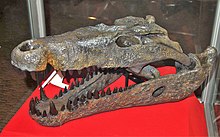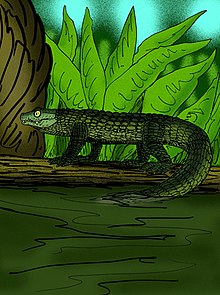Mekosuchinae
| Mekosuchinae | |
|---|---|

| |
| Restoration of the skull of Quinkana timara at the Central Australian Museum | |
| Scientific classification | |
| Domain: | Eukaryota |
| Kingdom: | Animalia |
| Phylum: | Chordata |
| Class: | Reptilia |
| Clade: | Archosauromorpha |
| Clade: | Archosauriformes |
| Order: | Crocodilia |
| Clade: | †Mekosuchinae Willis, Molnar & Scanlon, 1993 |
| Type species | |
| † Balouet & Buffetaut, 1987
| |
| Genera | |
Mekosuchinae is an extinct
Mekosuchine crocodiles are a diverse group. One of the last species, Mekosuchus inexpectatus from Holocene New Caledonia, may have been arboreal.[2] The early Miocene species Harpacochampsa camfieldensis may have resembled a false gharial. Another mekosuchine fossil, currently undescribed, has been found in Miocene deposits from New Zealand. One genus, Mekosuchus, managed to spread to the islands of the Pacific; it is believed to have island-hopped across the Coral Sea, moving first to a now submerged island known as Greater Chesterfield Island, then New Caledonia and onwards. In the Pleistocene, Quinkana was one of the top terrestrial predators of the Australian continent.
Mekosuchines underwent a drastic decline in post-Miocene Australia, with all genera, except for Quinkana and
While historically considered to be true
Phylogeny

Mekosuchinae is
Mekosuchinae is traditionally thought to be included as a
The below cladogram shows the results of the Lee and Yates study (2018), which placed Mekosuchinae outside of Crocodyloidea, as more basal than Longirostres (the combined group of crocodiles and gavialids).[5]
Crocodylia
|
| ||||||||||||||||||||||||||||||||||||||||||||||||||||||||||||||||||||||||||||||||||||||||||||||||||||||||||||||||||||||||||||||||||||
Other studies have recovered Mekosuchinae within Longirostres, belonging to Crocodyloidea, as shown in the alternative cladogram below.[1]
| |||||||||||||||||||||||||||||||||||||||||||||||||||||||||||||||||||||||||||||||||||||||||||||||||||||||||||||||||||||||||||||||||||||||||||||||||||||||||||||||||||||||||||||||||||||||||||||||||||||||||||||||||||||||||||||||||||||||||||||||||
References
- ^ PMID 36054424.
- ^ Naish, Darren (13 May 2009). "The small, recently extinct, island-dwelling crocodilians of the south Pacific". Tetrapod Zoology. ScienceBlogs. Retrieved 27 November 2010.
- PMID 34567843.
- PMID 28674657.
- ^ PMID 30051855.
- PMID 33907305.
- Mead, J. I.; Steadman, D. W.; Bedford, S. H.; Bell, C. J.; Spriggs, M. (August 2002). Guyer, C. (ed.). "New extinct mekosuchine crocodile from Vanuatu, South Pacific" (PDF). Copeia. 2002 (3): 632–641. S2CID 86065169.
